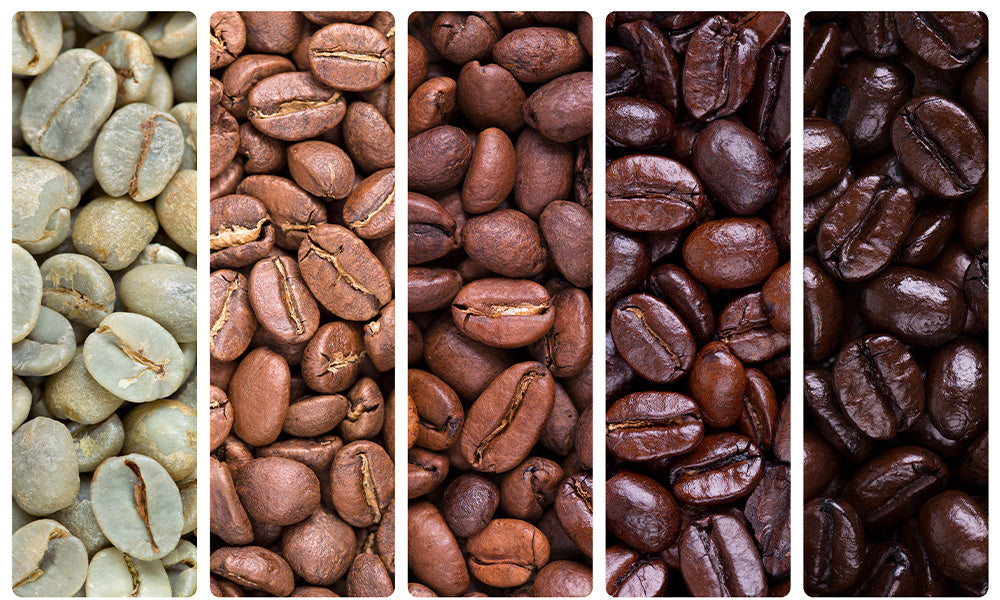
The Truth About Light vs Dark Roasts: Caffeine, Flavor and Freshness Unpacked
Share
As a coffee lover, I understand the importance of a perfectly roasted cup of java. However, there are several myths surrounding coffee roasting that might be impacting your brewing experience. In this article, I will debunk these common misconceptions and shed light on the truth behind the coffee roasting process.
Key Takeaways:
- There are several myths surrounding coffee roasting that can affect your brewing experience.
- Understanding the coffee roasting process is crucial in debunking these myths.
- Light roasts do not necessarily have less caffeine than darker roasts.
- Dark roasts do not automatically result in a stronger flavor profile.
- The concept of coffee needing to be freshly roasted for the best flavor is not always true.
Understanding the Coffee Roasting Process
The coffee roasting process plays a vital role in the development of the complex flavors and aromas that we love in our cup of joe. By gaining a deeper understanding of how coffee beans are roasted, you can appreciate the intricacies and debunk any myths that surround this crucial step in coffee preparation.
Roasting: Roasting is the process of heating coffee beans to transform their chemical and physical properties. It brings out the flavors and aromas locked within the beans, turning them from green seeds into the rich, brown beans we recognize.
During the roasting process, several chemical reactions occur, altering the beans' composition and producing the unique flavors we associate with different roast levels. These reactions include caramelization, in which sugars break down and contribute to the sweet, toasty notes, and the Maillard reaction, which creates desirable flavor compounds.
Roasting also affects the acidity, body, and bitterness of the coffee. Light roasts tend to retain more acidity and showcase the unique characteristics of the beans' origin, while dark roasts often have a bolder, fuller body with more pronounced bitterness.
Furthermore, the length of the roasting process has an impact on the overall flavor profile. Shorter roasting times result in lighter roasts, while longer roasting times produce darker roasts. Roasters carefully control the roasting time and temperature to achieve the desired flavor and aroma characteristics.
Roast Levels: Coffee beans can be roasted to different levels, each offering its own distinct flavor profile. Here's a breakdown of common roast levels:
| Roast Level | Description |
|---|---|
| Light Roast | Achieves a light brown color, highlighting the beans' origin flavors and acidity. |
| Medium Roast | Yields a medium brown color with a balanced flavor profile and slightly reduced acidity. |
| Dark Roast | Produces a dark brown color and a robust, bold flavor with decreased acidity. |
| French Roast | Results in a shiny, oily appearance, intense smoky flavor, and minimal acidity. |
Myth 1: Light Roasts Have Less Caffeine
One common myth about coffee is that light roasts contain less caffeine compared to their darker counterparts. However, this belief is not entirely accurate. The truth is that the roasting process itself does not directly impact the caffeine content in coffee beans.
Contrary to popular belief, the caffeine levels primarily depend on the type of coffee bean used rather than the roast level. For example, Robusta beans generally have higher caffeine content compared to Arabica beans, regardless of the roasting profile.
While it is true that lighter roasts tend to have brighter and more nuanced flavors, this does not indicate lower caffeine content. Light roasts are often preferred for highlighting the unique flavors of the coffee beans themselves, allowing their natural characteristics to shine.
It's also essential to note that the perceived strength or intensity of coffee does not solely rely on its caffeine content. The flavor profile and body of coffee are influenced by various factors, including the origin of the beans, brewing methods, and personal preferences.
Light roasts are revered for their vibrant flavor profiles and intricate tasting notes, making them a favorite among coffee connoisseurs seeking a more delicate and nuanced experience.
To further demonstrate the misconception about caffeine levels, here is a table comparing the caffeine content of different coffee roasts and their respective bean types:
| Roast Level | Bean Type | Average Caffeine Content (per 8 oz cup) |
|---|---|---|
| Light | Arabica | 80-100 mg |
| Medium | Arabica | 90-120 mg |
| Dark | Arabica | 80-120 mg |
| Dark | Robusta | 160-200 mg |
This table clearly shows that the caffeine content can vary significantly depending on the bean type and not solely on the roast level. Therefore, if you prefer a higher caffeine kick, opting for a coffee with Robusta beans, regardless of the roast, would be a better choice.
Myth 2: Dark Roasts Are Stronger in Flavor
One of the most common misconceptions about coffee is that dark roasts automatically result in a stronger flavor profile. However, this belief does not stand up to closer scrutiny.
Contrary to popular belief, flavor intensity in coffee is not solely determined by the darkness of the roast. The roasting process involves a delicate balance of time and temperature, which impacts the chemical reactions that occur within the coffee beans. These reactions contribute to the development of flavors and aromas.
While it's true that dark roasts tend to have bold and pronounced flavors, it is not an indication of strength. In fact, the strength of a coffee is primarily influenced by the ratio of coffee grounds to water during brewing, as well as the grind size and extraction time.
During the roasting process, the longer duration and higher temperatures associated with dark roasts can bring out different flavors compared to lighter roasts. This can include notes of chocolate, caramel, and even smokiness. However, the intensity of these flavors is subjective and can vary depending on personal taste preferences.
It's important to remember that flavor is a complex combination of factors, including the origin of the beans, the terroir, and the brewing method. Dark roasts should be appreciated for the unique flavors they offer, rather than assuming they are inherently stronger.
To further illustrate the variation in flavor profiles between different roasts, let's take a closer look at the table below:
| Roast Level | Flavor Profile |
|---|---|
| Light Roast | Fruity, floral, bright acidity |
| Medium Roast | Well-balanced, medium acidity |
| Dark Roast | Bold, rich, potential smokiness |
As you can see, flavor profiles can vary significantly depending on the roast level. It's important to explore different roasts and experiment with brewing methods to find the flavor that suits your preferences.
Myth 3: Coffee Should be Freshly Roasted to Enjoy Its Best Flavor
There is a common belief among coffee enthusiasts that freshly roasted coffee is essential for experiencing its best flavor. While freshness plays a role in the overall taste of coffee, it is not the sole determining factor. Let me clarify the truth behind this misconception and explore how the optimal time for coffee consumption can vary.
"Freshly roasted coffee is always the best."
Many coffee lovers adhere to this notion, assuming that the flavor of coffee rapidly declines after the roasting process. However, the reality is more complex.
The flavor of coffee is a result of various factors, including the quality of the beans, the roasting profile, and the brewing method. While freshly roasted coffee can offer vibrant flavors, it is not necessarily the only timeframe for enjoying exceptional taste.
After the roasting process, coffee undergoes a crucial stage called degassing. During this time, carbon dioxide that builds up within the beans is released, which can affect the extraction process and flavor profile. Consuming coffee immediately after roasting may result in a more intense, slightly uneven taste due to the residual carbon dioxide.
On the other hand, allowing coffee to rest for a few days after roasting allows the carbon dioxide to dissipate and the flavors to harmonize. This rest period, known as coffee's "flavor peak," often occurs between 3 to 14 days after roasting, depending on the specific coffee beans and roast level. During this timeframe, the flavors can develop and reach their fullest potential.
It's important to note that not all coffee beans have the same flavor peak. Factors such as the origin, processing method, and roast level can influence the optimal resting time. For example, light roasts generally require a shorter rest period compared to darker roasts, as their flavors tend to peak earlier.
Factors Affecting Coffee Flavor Development
The development of flavor in roasted coffee is a delicate balance influenced by multiple factors. Here are a few key elements:
- Bean Origin: Coffee beans sourced from different regions possess unique characteristics that contribute to their flavor development.
- Roast Profile: Each roasting profile highlights specific flavor notes, and the duration and temperature of the roast impact the overall taste.
- Brewing Method: The brewing method, such as pour-over, French press, or espresso, can extract different flavor components from the roasted coffee.
To illustrate the variation in coffee flavor development, here's a table showcasing the optimal resting time for different roast levels:
| Roast Level | Optimal Resting Time |
|---|---|
| Light Roast | 3-5 days |
| Medium Roast | 5-7 days |
| Dark Roast | 7-14 days |
As you can see, the flavor peak varies depending on the roast level, indicating that there is no universal rule for the optimal time to consume freshly roasted coffee.
In conclusion, while freshness is indeed a crucial factor in coffee enjoyment, freshly roasted coffee is not the only window for savoring exceptional flavor. Understanding the various factors that contribute to flavor development and finding the ideal resting time for your preferred roast level can help you experience the full potential of your coffee.
Take Away
It's important to separate fact from fiction when it comes to coffee roasting. By dispelling common myths, you can enhance your coffee brewing experience and truly appreciate the richness and complexity of a perfectly roasted cup of coffee.
Throughout this article, we explored various myths related to coffee roasting and debunked them with factual information. We learned that light roasts don't necessarily have less caffeine, and dark roasts don't automatically result in a stronger flavor. Additionally, we discovered that coffee doesn't have to be freshly roasted to enjoy its best flavor.
It's worth noting that coffee roasting techniques can vary depending on the origin of the beans. Take Costa Rica, for example. Costa Rican coffee is renowned for its exceptional quality, and the roasting process plays a crucial role in bringing out its unique flavors. By understanding the nuances of coffee roasting, you can highlight the distinct characteristics of beans from different regions, making each cup a truly delightful experience.
So, the next time you brew a cup of coffee, remember the truths we uncovered today. Don't let myths limit your enjoyment and exploration of the wonderful world of coffee. Embrace the art of coffee roasting, savor the flavors, and celebrate the diverse coffee cultures from around the globe.
